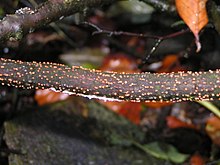| Nectria cinnabarina | |
|---|---|

| |
| Scientific classification | |
| Domain: | Eukaryota |
| Kingdom: | Fungi |
| Division: | Ascomycota |
| Class: | Sordariomycetes |
| Order: | Hypocreales |
| Family: | Nectriaceae |
| Genus: | Nectria |
| Species: | N. cinnabarina
|
| Binomial name | |
| Nectria cinnabarina (Tode) Fr. (1849)
| |
| Synonyms | |
|
Cucurbitaria cinnabarina | |
Nectria cinnabarina, also known as coral spot, is a plant pathogen that causes cankers on broadleaf trees. This disease is polycyclic and infects trees in the cool temperate regions of the Northern Hemisphere.[1] N. cinnabarina is typically saprophytic, but will act as a weak parasite if presented with an opportunity via wounds in the tree or other stressors that weaken the tree's defense to the disease.[2] A study published in 2011 showed[3] that this complex consists of at least 4 distinct species. There are only a few ways to manage this disease with techniques such as sanitation and pruning away branches that have the cankers.[4] N. cinnabarina is not as significant a problem as other Nectria spp., some of which are the most important pathogens to infect hardwood trees.[5]
- ^ Cite error: The named reference
:0was invoked but never defined (see the help page). - ^ Cite error: The named reference
:3was invoked but never defined (see the help page). - ^ Hirooka, Y; Rossman, AY; Chaverri, P (2011). "A morphological and phylogenetic revision of the Nectria cinnabarina species complex". Stud Mycol. 68: 35–56. doi:10.3114/sim.2011.68.02. PMC 3065984. PMID 21523188.
- ^ Cite error: The named reference
:4was invoked but never defined (see the help page). - ^ Cite error: The named reference
:5was invoked but never defined (see the help page).